How to grow cannabis in Rockwool
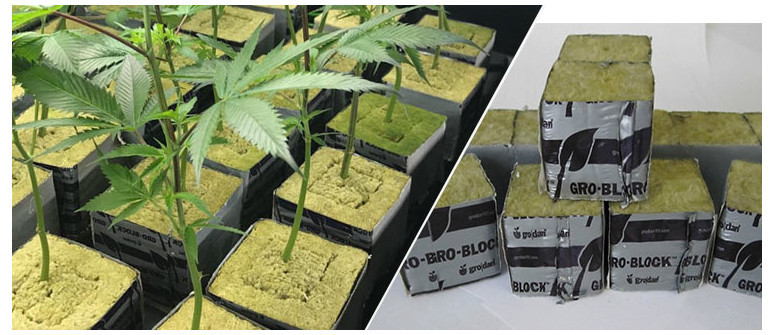
Interested in using Rockwool to grow cannabis? Perhaps you've mastered the soil grow and fancy getting a bit more high-tech with hydroponics. If so, you're going to need a suitable medium. Here, we discuss the pros, cons, and protocol of using Rockwool to grow cannabis.
Contents:
Growing cannabis in Rockwool is very common among those who use hydroponic methods. It is a simple medium that aerates well and gives the grower a lot of control. But is it right for you? That depends. The broader question is whether a hydro grow is right for you. They can be a lot of effort, but the rewards are great, too.
As a population, we’re all becoming more environmentally conscious by the day, and of all the growing media available to us, Rockwool doesn’t have the most sustainable credentials. Below, we’ve outlined all we know about growing cannabis in Rockwool, including its benefits and drawbacks, to help you make an informed decision.
What Is Rockwool?
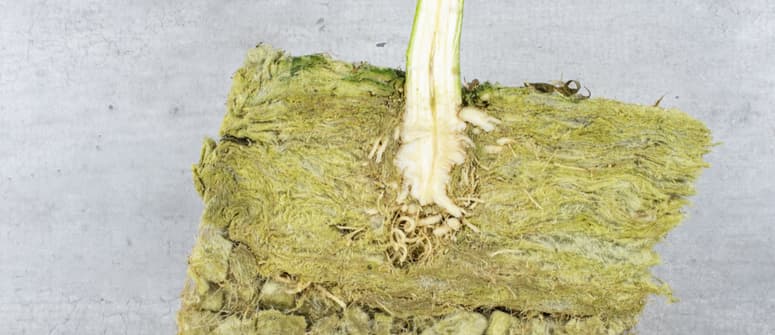
Rockwool is the branded name of mineral wool or stone wool. Although Rockwool is the name of a Danish company and their specific product, it has gone on to become the generic term for the product itself, whomever it is made by. It is used most commonly as a form of insulation, both in houses and around hot pieces of machinery. As it has a lot of air gaps, it is very insulative.
This property also makes it great for hydroponic growing. Why? Because it allows for good drainage and aeration. Moreover, the roots of cannabis plants are easily able to penetrate the many cavities in Rockwool. However, if you intend to use it, make sure you have a type specifically designed for horticulture, as industrial Rockwool can be toxic.
How Is Rockwool Made?
Rockwool is an artificial version of Pele’s hair. This phenomenon occurs when wind blows through molten lava and leaves it as fine strands. Rockwool is created by either blowing air through molten basalt slag, or winding it—the same way cotton candy is made. It is then pressed into the shapes in which we use it.
Advantages and Disadvantages of Rockwool for Growing Cannabis
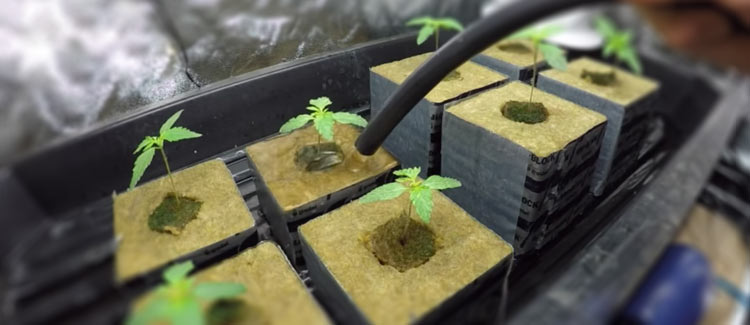
Rockwool is a medium suited for hydroponic methods, and therefore comes with the usual ups and downs of a hydro setup. It’s one of those methods that, if it goes well, is very good—but it can also go quite wrong. So you’ll need to be willing to put in the effort if you intend to grow weed in Rockwool.
Advantages of Growing Cannabis in Rockwool
- Rockwool does not lock out or buffer fertilisers. What is present in the nutrient solution at any time is available to the plant. This simply means that any nutrients or additives provided will have an immediate effect.
- Rockwool provides very little resistance to roots, so they penetrate the medium very easily. This quickly increases root surface area, nutrient uptake, and plant development.
- It is possible to germinate directly into Rockwool cubes, then transfer the cubes into bigger blocks as the plants grow. This means less stress on the plants at each upscaling, and uninterrupted growth.
- So long as the correct moisture levels are not exceeded, Rockwool offers excellent air penetration into the rhizosphere (root zone).
Disadvantages of Growing Cannabis in Rockwool
- It is not very environmentally friendly. It takes substantial energy to produce, and is not recommended to be used more than once.
- It is relatively expensive.
- Excess water can cause algae buildup. Make sure there is plenty of air circulation over the grow blocks to aid in evaporation.
- Rockwool fibres can be harmful if they become airborne. Wear a dust mask when handling in the dry stage. Do not remove the plastic coatings.
- Rockwool can be susceptible to pH swings. Continually monitor the runoff and adjust the nutrient solution to suit.
- Rockwool has a naturally high pH—too high for cannabis—so this has to be amended.
Are Rockwool Fibres Dangerous?
It’s unclear whether the fibres are dangerous. So far, there is little evidence of serious health risks associated with Rockwool. That’s not to say it isn’t unpleasant, though. If you’ve ever worked with it, especially in its insulation form in an enclosed space, you’ll know just how horrible a material it can be. The tiny fibres become dislodged and find new homes in your skin, eyes, throat, and lungs. Painful and incredibly itchy, it’s an uncomfortable material to come into contact with. So while it may not pose any long-term dangers, it is recommended to wear goggles, a mask, and gloves when working with it.
How To Use Rockwool To Grow Cannabis at Home
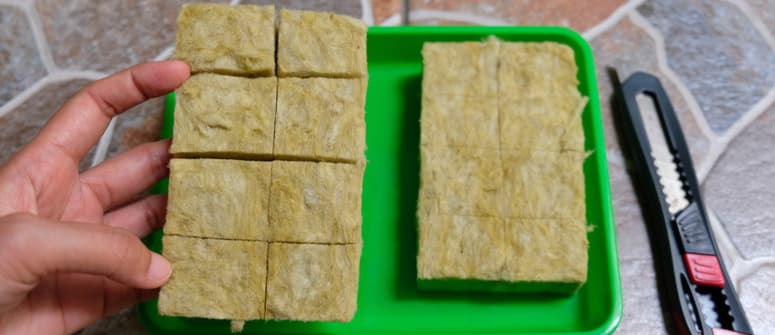
The great thing about Rockwool is that it can be used for the whole life cycle of the plant. If you’re intending to grow using a Rockwool substrate, you’ll want to know how to do so effectively. This following description is aimed at the beginner indoor grower utilising a deep water culture (DWC) hydro system. If you’re growing outdoors, or with another system, adapt as necessary; the fundamentals should remain.
Materials
- Humidity dome
- Rockwool cubes (for transplanting)
- Container for water reservoir—the size will depend on how many plants you’re growing
- pH-balancing solution
- Fertiliser
- Lights—the choice is yours, but full-spectrum LEDs are long-lasting and use little power
- Net pots
- Clay pebbles
- pH meter
- EC meter
- Cannabis seeds!
Where To Buy Rockwool?
You’ll probably want to shy away from the insulation type of Rockwool. Not least of all because it comes in giant rolls that are the wrong shape for growing weed. Instead, you can find Rockwool cubes specifically designed for growing either online or in most garden centres.
Directions
Following these steps should get you off to a good start growing cannabis in a Rockwool medium.
1. Preparation: Hydrating and Stabilising the Rockwool Cubes
Rockwool has a pH of about 7.0, which is too high for cannabis. Cannabis grown in hydro likes a pH closer to 6.0. If the pH is too high or too low, then nutrient lockout will occur. This means that the roots will struggle to absorb the necessary nutrients, either stunting their growth or killing them. No good!
For cannabis seeds, though, you’ll want the pH to be 5.5. This will increase as the plant ages.
So, to remedy this, it’s important to prepare Rockwool properly. To do so, soak it for 24 hours in a solution with a pH as low as 4.5, and an EC level of 0.4–0.5.
To check if it’s ready, drench it with a pH solution of 5.5 and measure the runoff. If it’s no different to the solution added, then it’s ready for your seeds. If it’s higher, then repeat the process until there’s no change.
2. Germination: Plant Your Seeds in the Rockwool Cubes
Most Rockwool cubes will come with a hole cut out in the middle for your seeds. If not, cut one yourself; 1–2cm should suffice. It’s important that the shoots don’t need to try very hard to emerge once the seed opens.
Place one seed in each block. Cover lightly with Rockwool; there’s no need to compress it. All you want to do is create a dark, humid environment.
Water it with a pH-balanced solution and leave it a dark, warm place. Cover with a humidity dome if possible.
There are many methods of germination. Some involve germinating seeds in one pot, and then transplanting the seedlings into the final medium once they reach a certain size. While this comes with some advantages, the novice grower also risks damaging the roots during transplanting, which, of course, does more harm than good. So often the best option is to germinate seeds in their final pot/medium.
3. Let the Plants Grow for a Bit
Once the seedlings emerge, just leave them be for a bit. This is the stage at which they are most fragile and vulnerable, and any shock could kill them. When watering, make sure they have moisture, but there’s no need to totally soak them at this stage; they don’t need much. A touch test should tell you whether they need watering or not.
A note on nutrients. Seedlings need very little in the way of nutrients, so it’s important not to overfeed, as this can also kill them. In soil it is simpler; you can just not feed them. But in inert Rockwool, it’s important to exercise restraint.
4. Transplant the Seedlings Into Your Hydro System
Once the roots begin to appear from the bottom of the Rockwool cube, around 2–3 weeks in, it’s time to transplant them into your hydro system. As soon as you see the roots emerge, don’t hesitate, or they will wrap around the cube.
Using net pots/cups with clay pebbles, suspend the seedlings above the water reservoir. Soon you will see the roots growing through these to find the water, where they will dangle suspended and (hopefully) happy.
Can Rockwool Be Planted in Soil?
Yes, you can technically just use Rockwool to germinate your cannabis seeds, and then transplant into a soil medium. However, due to the extra effort of pH control and maintaining nutrient levels, this would be an unnecessary effort if your final goal is not a hydroponic grow.
Maintaining a Rockwool Grow
Different stages of the grow will require different pH/EC levels, amounts of water, and so on. Below we’ll outline what these are.
Vegetative Stage
At this stage you’ll want the pH to be low—about 5.5. In terms of nutrients, about 60–70ml of fertiliser for each plant will be enough. Make sure you’re using a fertiliser with the right NPK (nitrogen, phosphorus, and potassium) breakdown—about 1:1:1 NPK—as the balance will change once plants enter the flowering stage.
Flowering Stage
- Week 1: You’ll want to up your pH to about 5.8 or 5.9 now. Also, the nutrient balance will change from 1:1:1 NPK to 1:2:2. Too much nitrogen during the flowering stage is bad for your plants.
- Weeks 2 and 3: Increase pH to 6.0 and the EC to 0.8–0.9.
- Weeks 4 and 5: Increase EC to 1.0–1.2, and fluctuate pH between 6.0 and 6.2 to ensure complete nutrient uptake.
- Week 6: EC to 1.4, continue to fluctuate pH.
- Week 7: EC to 1.6–1.7, fluctuate pH between 6.0 and 6.3.
- Week 8: EC to 1.8.
- Final week(s): Drop EC as low as possible and keep pH at 6.2. Some suggest that by “flushing”, you remove salt buildup in the plant and improve the final taste.
Is Rockwool Reusable?
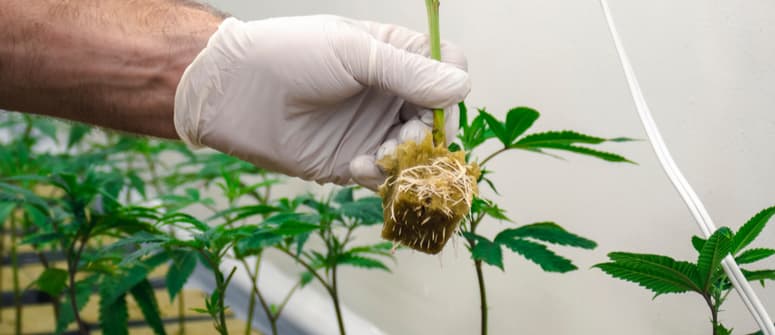
It can be if you really want to put in the work, but it’s difficult. Using Rockwool again will come with pH fluctuation issues that are difficult to control. Plus, the root matter remaining in it can cause issues. If you do want to use it again, you’ll have to remove all organic matter and steam it at 100°C.
It cannot be easily recycled, nor does it break down, although the Rockwool company does offer a means of recycling it. However, the takeaway is that it’s by no means the most sustainable option.
Growing Cannabis With Rockwool: The Takeaway
It’s hard to say whether Rockwool is the best choice or not. If done well, there is no doubt that it offers a fantastic, and fairly simple, substrate for beginners. Being inert and breathable, it offers a safe and hospitable home for your roots.
On the other hand, it is not very environmentally friendly. So it’s up to you to decide. If you want to get into hydroponic growing, maybe use it to get yourself started and then try something else. But if your main concern is the environment, perhaps look elsewhere.




